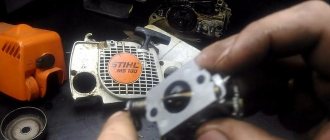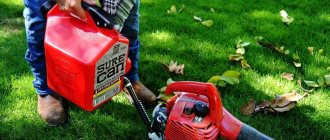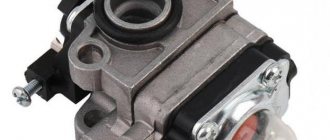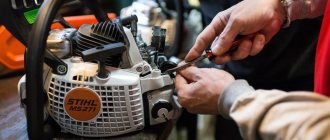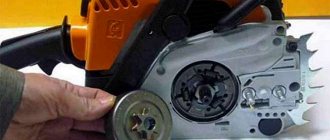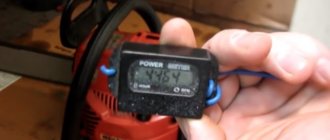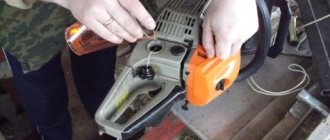Why does a chainsaw stall when you press the gas?
Let's say the chainsaw operates normally at idle, but when you press the gas sharply it stalls. What could be the reason? It is immediately clear that the issue is not the ignition (lack of spark), because if the ignition was faulty and there was no spark, the tool simply would not start. This means the fuel system remains.
There are a lot of malfunctions in the fuel system, and to determine the exact reason why the Stihl 180 chainsaw stalls when you press the gas, it is necessary to carry out a complete diagnosis of it. We recommend reading about common malfunctions of the Shtil 180 chainsaw and their elimination.
Filter check
The first thing you need to check is the fuel filter.
In some cases, a filter clogged with dirt is unable to pass through the fuel mixture in sufficient quantities. Accordingly, there is a shortage of fuel in the system, which leads to the fact that when you press the gas of the chainsaw, the fuel burns out, and new fuel does not yet have time to arrive, as a result of which the Shtil chainsaw stalls. Also, if the fuel filter is clogged, there may be a noticeable drop in the power of the chainsaw at maximum speed, but this is with minor contamination.
Air filter
On the pages of the World Wide Web, you can find information that the Shtil 180 chainsaw may stall due to severe contamination of the air filter. I would like to refute this not entirely correct information and report that the Shtil MC 180 carburetor is equipped with a compensator, which is designed and installed in order to take in the air necessary for the normal operation of the Shtil 180 chainsaw, bypassing the dirty air filter. Of course, the power with a clogged air filter will drop slightly, but it definitely won’t stall. The power may also drop due to piston wear, which will require repair of the Stihl MS 180 piston chainsaw.
Carburetor
One of the reasons why a chainsaw does not develop speed when you press the gas, but rather stalls, is a malfunction of the carburetor. Let’s say the Shtil 180 saw worked properly, and then it was installed for a long time and was not used. Afterwards it was started, and at idle it works well, but when you press the gas it can stall. Why does it stall? The reason is a stuck carburetor valve nozzle. Of course, this is not 100%, but the probability of such a malfunction is high. We recommend reading the article about the design and repair of the Shtil 180 carburetor.
In order to check the nozzle, you need to remove the carburetor and disassemble it. To remove, you need to unscrew the two nuts securing the air filter and the carburetor, then remove the air filter and the engine control lever, while disconnecting the air damper control rod from the carburetor. Next, you need to slightly pull the carburetor towards you and disconnect the fuel supply hose.
You need to remove the fuel hose as carefully as possible and prepare a plug for it in advance, since fuel should come out of it.
After removing the carburetor, you need to blow it out and clean it of dirt, only after that the carburetor can be untwisted.
It is necessary to unscrew the cover of the main chamber of the carburetor; this is the one on which the compensator is installed on top. Next, use an 8 mm bolt and a length of at least 50 mm. We knock out the valve.
It is necessary to knock out the valve by placing the carburetor on a wooden stand, this will protect it from damage to the body.
After the nozzle is removed, you can blow it out using a compressor. The valve should only allow air to flow in one direction; if the valve can be freely blown in both directions, it means it is faulty and needs to be replaced with a new one. Reassembling the chainsaw after the valve has been repaired must be carried out in the reverse order of disassembly.
You can see clearly how a carburetor is repaired, or rather, how to correctly knock out the injector valve from the carburetor body by watching the video.
Another common reason why a saw may stall when the speed increases is air leaking into the carburetor. This can only be checked with a special tool, but it is worth noting that if preventive work has not been carried out on the carburetor for a long time, then you can install a new set of gaskets in the carburetor. In some cases, this helps solve the problem of its depressurization.
When disassembling the carburetor to replace the gaskets, you need to carefully inspect its needle valve, press the rocker arm and check its lifting. Sometimes, especially after the Stihl chainsaw has stood for a long time with fuel in the carburetor, the needle may burn to the carburetor body and not perform its functions. Simply put, the needle valve will not allow the fuel mixture to pass through. In this case, the saw will not work.
Video review
Carburetor repair overview
Review: the chainsaw starts and stalls. Reverse air leak into the tank
Review: won’t start, starts and stalls: how to fix?
Ivan Samoilov, 38 years old, Amur region
“My Chinese saw doesn’t start well; in general, we can say that it doesn’t start, because it immediately stalls. I start it up through rather complex manipulations, at full throttle it works and saws for some time. However, after a short time it begins to sneeze and stalls - it is impossible to work. I tinkered with it myself for a long time, and then took it to the workshop. It turned out the magneto came off - I never would have thought it was the fault of the carburetor.”
Ivan Vesnin, 33 years old, Solnechnogorsk district
“After winter I decided to take my chainsaw for a walk in the garden. Right away everything went well, I managed to start it up quite quickly, after warming up I even trimmed one apple tree, and then it began to stall. It will run for 8-10 minutes and then die. And not only under load, but also at idle. I was already scared - I decided that it was time to change the piston.
Yakov Baulov, 59 years old, Siberian Federal District
“After a long period of inactivity (I didn’t approach it for the whole winter), the chainsaw began to stall at high speeds and when the gas was sharply applied. It seems to start gaining momentum, but when adding gas, at some point it stalls. It didn't start very well from the very beginning, but I adjusted the carburetor and it seemed to work out. In short, I searched for the fault for a very long time until I climbed into the gas tank and discovered that my chainsaw was not equipped with a fuel filter - there was simply the edge of the fuel line sticking out.
Why does it stall at idle?
The first and most common cause of this malfunction is incorrect carburetor adjustment. You can adjust the idle speed yourself; for this you need to have a Stihl adjusting screwdriver, which is supplied with the unit. The adjustment hole is located on the right side of the Shtil 180 saw on the handle and is indicated by the symbols “-” and “+”.
If the Stihl chainsaw does not maintain speed and stalls at idle, you can be almost 90% sure that it has a malfunction in the fuel pump operating system, as a rule, this is air leaking into the crankcase through the pan gasket, or, more often, through the oil seals crankshaft. Air leakage reduces or completely stops the impulse, which is supplied through special channels to the fuel pump of the chainsaw. As a result of this, the Stihl 180 chainsaw does not receive the required amount of fuel and stalls at idle.
Diagnostics can be carried out using a special device called a vacuum gauge.
The second way to check the performance of the oil seals is to pour gasoline into the engine crankcase and look at them; if the oil seals leak gasoline, it means they cannot provide normal pressure in the crankcase, which will make idling impossible. And when operating at high speeds, with leaky oil seals, there is a possibility of the crankshaft bearings jamming.
The algorithm for checking the Shtil 180 crankcase and seals for leaks is as follows:
- The top cover is removed.
- The air filter housing and carburetor are dismantled.
- The chainsaw handle is removed.
- The starter spins up and retracts.
- On the side opposite the starter, the side cover and drive sprocket are removed.
- A piston stopper is installed in the spark plug hole or a string from an old starter with knots tied on it is stuffed into the cylinder.
- The flywheel and clutch are unscrewed, after which the parts are removed. It is worth knowing that the chainsaw clutch has a left-hand thread and unscrews clockwise.
- The oil pump drive gear is removed.
Conclusion
If the first signs of loss of power (reduction in speed) appear with the Shtil MS 180 chainsaw, under no circumstances should you continue to work, but you should immediately contact a specialist or carry out diagnostics and fix the malfunction yourself. There are not many reasons for power loss and you can cope with them even without certain skills. The main thing is to calmly analyze the behavior of the saw and find out the reasons why it stopped pulling (the speed dropped), and eliminating the malfunction is not a difficult task.
There are often cases when owners of chainsaws are faced with their breakdown and it does not matter at all what model of this type of equipment, since the nature of the breakdowns is almost the same for all. Well, the chainsaw has stalled, so what next? Undoubtedly, you can take the equipment to specialized services that will repair your “iron friend” for a fee. But as they say: why pay more?
After all, you can personally disassemble the instrument and repair it, since the damage may be insignificant, but in the service you will pay a lot for this. But naturally, in order to bring a tool back to life yourself, you need to be able to understand the reasons for its breakdown and how to troubleshoot it. So let's learn! In this article you can find answers to questions regarding situations when the tool simply stalls after directly pressing the gas. So let's get started.
Why does it stall at full speed?
Very often you can hear the question why a chainsaw stalls at full speed. There may be several reasons. First, you need to consider exactly how the saw stalled. Let's say the tool was working normally and suddenly, for no apparent reason, it suddenly stalled and the starter does not turn over. In such a situation, you can be 100% sure that the chainsaw is jammed and you need to start overhauling it.
The second situation is when the Shtil 180 chainsaw worked normally, then gradually lost power in a short time and stalled, and the cylinder overheated. In this case, the most likely reason is air leakage under the rubber pipe connecting the carburetor to the cylinder or its rupture. The mixture became lean, resulting in overheating. The cause can be eliminated by changing the pipe.
General information
The characteristics of this saw are a source of pride for the German manufacturer. At the same time, the unit is a tool that is designed to perform a small amount of work. The tool is positioned for domestic use, which confirms the intensity of its use, which should not exceed 20 hours per month . Having such a unit at your disposal, it will not be difficult for you to maintain order in your garden, prepare firewood for the winter, and also clear areas. At the same time, he will be able to help you in solving other problems where there is no need to perform complex manipulations.
Main characteristics
The saw in question can be considered a compact option, because its weight is only 3.9 kg. At the same time, it has a large capacity oil and fuel tank. The device performs its operating functions using a two-stroke engine, the power of which is sufficient to solve simple tasks. In addition to this, during operation this tool does not create much noise, the level of which does not exceed 98 dB . For ease of understanding, it is enough to say that human speech creates noise at a level of 76 dB.
- The Stihl 180 chainsaw has a power of 2.6 watts. In principle, this is enough, remembering that we are talking about a tool for household use.
- The capacity of the oil tank is 0.145 l, the fuel tank is 0.25 l.
- The tire provided by the design has dimensions of 350 mm, with a pitch of 0.325 inches.
Winding device
As with other saws, the carburetor plays the role of the main starting device. Looking in more detail at the carburetor that the Stihl 180 chainsaw is equipped with, it should be noted that it has a single adjustment screw. In other words, it is a kind of idle adjustment screw . In this case, the jet, which bears the full load, is motionless all the time.
In other words, the regulation is not applicable to him. In turn, there is no way to influence the full load in any way. You also need to pay attention to the factory settings, due to which the air-fuel mixture is supplied directly to the engine. Moreover, this principle remains unchanged regardless of the operating conditions of the tool.
Read also: Steel striker striking part of a pneumatic hammer
The main reasons for chainsaw failure
Although the chain saw is a simple device, from time to time problems arise in its operation, which can only be eliminated by disassembling it. Examples include the following faults:
- the chainsaw does not gain speed;
- the chainsaw stops functioning when cutting;
- the chainsaw starts and stalls;
- the chainsaw loses its power;
- The chainsaw stalls when pressed.
Most often, malfunctions are associated with interruptions in the functioning of the motor, as well as with malfunctions of other systems and components. Proper handling of this equipment is of great importance. If all the rules of use are followed, problems with a high probability lie in the most obvious ones. When looking for the causes of problems, it is advisable to start by checking the simplest part of the chainsaw and finish with the most complex.
External inspection of the spark plug
A visual inspection of a spark plug can tell you a lot about engine performance:
- A raw working part that is wrapped in a cylinder indicates a malfunction in the power system.
The fuel mixture is too rich. Carburetor adjustment required. Or the ratio of oil to gasoline is incorrect. There is more oil poured than normal and it does not have time to burn during the working stroke of the piston. Soot appears. You need to clean it off with sandpaper. Under no circumstances should you heat a candle with an acetylene or gasoline torch. After this, the inner part of the candle may separate. - Weak spark. To see the spark, you need to unscrew the spark plug. Then a high voltage wire is connected to it, the spark plug is pressed against the cylinder with its metal part. Then you need to pull the starter, and at this time look at the spark plug electrodes. A weak, unstable spark may indicate poor contacts in connection with a high-voltage wire, or an incorrect gap between the electrodes. Different spark plugs have this gap from 0.5 to 0.7 mm. As the internal electrode gradually burns out during operation, the gap increases. To restore the distance, you need to knock the outer electrode a little, or install a new spark plug.
- Spark plug depressurization. Sometimes you can notice a dark edging between the spark plug insulator and the metal nut. This indicates that the metal part has come off the ceramic. With such a spark plug, the chainsaw stalls or works intermittently. This happens because the spark strikes the cylinder through the spark plug body. Depressurization can occur with a cheap, low-quality spark plug, or if it was over-tightened at the time of installation.
Checking the main chainsaw systems
If the chainsaw refuses to work normally, you need to make sure that all the conditions required for its normal functioning are provided:
Then you need to sequentially check the functioning of all its elements. First you need to check the fuel tank. If the reason is not the volume or quality of the fuel, then the likely cause of the malfunction may be the spark plugs. The spark plug gap should not exceed 0.5 millimeters. If it is too small, this means that carbon deposits have deposited on the candles. In this case, you should remove the spark plugs, clean them, then put them back in place and try to start the chainsaw. In addition, it is advisable to completely replace the spark plugs with new ones from time to time, even if they are in good condition.
Then you need to check the condition of the fuel filter and carburetor. Cleaning the fuel filter yourself is not a difficult task, but carburetor repair is best left to specialists.
Additional Tips
First of all, what you should remember when purchasing this kind of tool is that certain parts of the saw need to be replaced with new ones after their service life (passport) has expired. It is for this reason that the instructions should always be at your fingertips, since everything is described there in detail.
These types of parts include: a sprocket (drive), a tire, part of the system (anti-vibration), as well as a chain . Since we should not forget that if this “filling” is not replaced with a new one at the required time, then these worn-out spare parts will negatively affect the remaining parts of the chainsaw. It is for this reason that you should check the depth of the immediate tooth cutting quite often. Remember that it should not be higher than 0.5 mm a week.
The chainsaw starts and stalls - the reason
If the chainsaw starts and stalls during the first attempts to do the job, then the reason may be problems with the chain brake or its jamming due to lack of lubrication. In this case, measure the oil level. If the amount of lubricant is sufficient, then the reason may lie in the tube that leads it to the lubrication mechanism.
Another reason could be a carburetor failure. If it only needs adjustment, you can do it yourself according to the instructions. If the carburetor needs cleaning or repair, then you cannot do without the help of professionals.
Another possible cause of this malfunction is a low fuel level in the tank. In this case, the chain saw stalls when tilted, since the remainder of the fuel mixture ends up in the part of the tank opposite to the place where the suction tube is located.
Return under warranty and post-warranty service
Chainsaw maintenance includes:
- Monitor the quality of gasoline and oil on the basis of which you prepare the fuel mixture. Stick to the correct proportions when doing this;
- Do not use fuel prepared more than two weeks ago. Regularly check and clean the gasoline and oil tanks, otherwise the engine will stall or the saw will not start at all;
Chainsaw chain maintenance
- Clean the air filter regularly. It has a simple device and this operation will not require much effort from you;
- Turn the bar over every time after the next sharpening of the chain - this will extend the service life of the saw set;
- Regularly check and thoroughly clean the oil inlet and outlet ports, oil channel and guide bar groove. Remember that if the automatic lubrication system is faulty, your saw will start or stall;
Currently reading: Cedar hedge trimmer
Your main assistant should be the instruction manual. If you have lost it, you can contact the dealer of the company whose chainsaw you use; they will provide you with instructions in electronic form.
So, before each time you turn on a gasoline chain saw, be sure to check that the chain is in good condition, whether its teeth are sharpened, and whether it is well tensioned (does not sag, but is not too tight, it can be pulled a little away from the blade).
You can sharpen the chain using a special machine or a file with a special template (depending on the tooth pitch of the chain, there are different templates).
Every time after use, the chainsaw must be cleaned: the chain, bar, air filter, housing, cooling fins, cracks and other grooves are cleaned of sawdust. After using the saw, turn the bar over so that it wears evenly, lubricate the sprocket (if there are grooves for lubrication in the front of the saw).
During long-term storage, be sure to drain the fuel and oil! The chain and the bus form an electrochemical pair, so they rust together and must be stored separately.
Why does a chainsaw stall when heating up?
It often happens that the chainsaw starts when cold, but stalls when it warms up. This behavior of the tool can be caused by the following reasons:
- The carburetor is not adjusted correctly. This problem can be identified by how the device starts up when cold. If it is carried out without closing the air damper, and the engine starts without a preliminary flash, this means that after the engine warms up, fuel floods the spark plug. The solution to this problem is to adjust the carburetor. Details about carburetor adjustment
- Malfunction of the coil (ignition module). This problem can be identified by sequentially checking the spark, first on a cold and then on a hot engine. If there is no spark on a hot engine, then you need to replace the ignition coil.
- Spark plug faulty. In this situation, as in the case of a faulty ignition module, the spark disappears when the engine heats up. You need to replace the spark plug with a new one, and if this does not solve the problem, you should check the ignition module and the distance between it and the flywheel.
To sum it up...
Definitely, every item we buy has its own expiration date and sooner or later it breaks, and it becomes a shame when the degree of its breakdown is so great that it cannot be repaired. But you must admit that quite often we are simply negligent in our use of technology (see about proper operation and how to properly cut down a tree so that it falls in the right direction), and when it stops working, then we try to find ways to fix the breakdowns, resulting in a huge number of services.
But remember that even though the equipment breaks down, we can extend its “life” . All that is necessary is to simply take care of it, break it in after replacing parts (read how chainsaws are broken in here) and keep its spare parts clean and tidy. And then, undoubtedly, it will serve for many more years. It is also important to use exclusively high-quality spare parts and “additives” (see attachments for chainsaws). Then your equipment will work smoothly, and you will simply forget what repairs are.
We also recommend that you familiarize yourself with the Shtil ms 180 chainsaw.
For what reasons does Shtil 180 stall at idle or full throttle?
Any tool can break and the Stihl MS 180 chainsaw is no exception. Today we will try to understand such questions as: why the chainsaw stalls when the speed increases, also at idle and at full speed. Let's consider options for diagnosing and troubleshooting problems associated with this behavior of the Shtil 180 chainsaw.
IMPORTANT. An experienced electrician leaked to the network the secret of how to pay half for electricity, a legal way. Read more
Why does a chainsaw stall under load?
Sometimes the chainsaw is unable to function properly under load. Most often this is caused by improper adjustment or leaking carburetor. In addition, the cause of this problem may be air leaks through the carburetor gasket or crankshaft oil seals. A tool that is unable to function under load will also not be able to reliably maintain idle speed.
Diagnostics begins with checking the carburetor and crankcase for leaks. If air leaks through the crankshaft oil seals are detected, they must be replaced. If air leaks are detected in the carburetor, installing a repair kit of gaskets is required to solve the problem.
If these actions do not lead to the desired result and the engine crankcase and carburetor are sealed, then you need to adjust the carburetor.
If a Husqvarna chainsaw stalls under load, then in case of any deviations in the functioning of the motor, you should first of all check the impulse hose, since this is the most common cause of failure of chainsaws of this brand.
Muffler
What's first, you ask? The answer is a muffler. The muffler is responsible for exhaust gases and suppressing flames in them. All combustion products pass through it, which can eventually clog it. A clogged muffler situation is not unusual, but is caused by an incorrect fuel mixture.
With a normal ratio of gasoline to oil, the combustion products are not saturated with soot sufficient to clog the muffler. If there is more oil than normal when it burns, excessive carbon deposits will form. In addition, sludge builds up under the piston rings and in the muffler of the Calm 180 chainsaw. So, smoked muffler, the most harmless thing that can happen, the maximum damage from excessive carbon emissions, is the need to replace the piston.
Cleaning the fuel filter
If there is insufficient fuel supply, the chainsaw stalls when accelerating. The reason may be a clogged fuel filter and improper carburetor operation. How to check if the filter is at fault? To do this, you need to partially disassemble the tool body to gain access to the carburetor. Disconnect the fuel hose from it and press the fuel pump several times. On modern saws, this is a transparent rubber hemisphere that is pressed before starting the engine.
If gasoline begins to splash out of the hose vigorously, then the filter is in order. If fuel flows reluctantly, then you need to change or clean the filter.
It is located inside the gas tank, and to get it out, you need to remove the plastic protection, then use a flat screwdriver to pry off the rubber cuff through which the fuel line passes. You must remove it carefully so as not to damage the rubber. Otherwise, it will leak after installation. In some chainsaws, the filter is removed through the neck of the gas tank.
There is a fuel filter at the end of the fuel line installed in the tank. Usually it becomes clogged with tarry deposits found in gasoline and oil. The filter is pressed into the hose and can be removed by simply pulling it out. It must be washed in hot water with cleaning agents or replaced with a new one.
